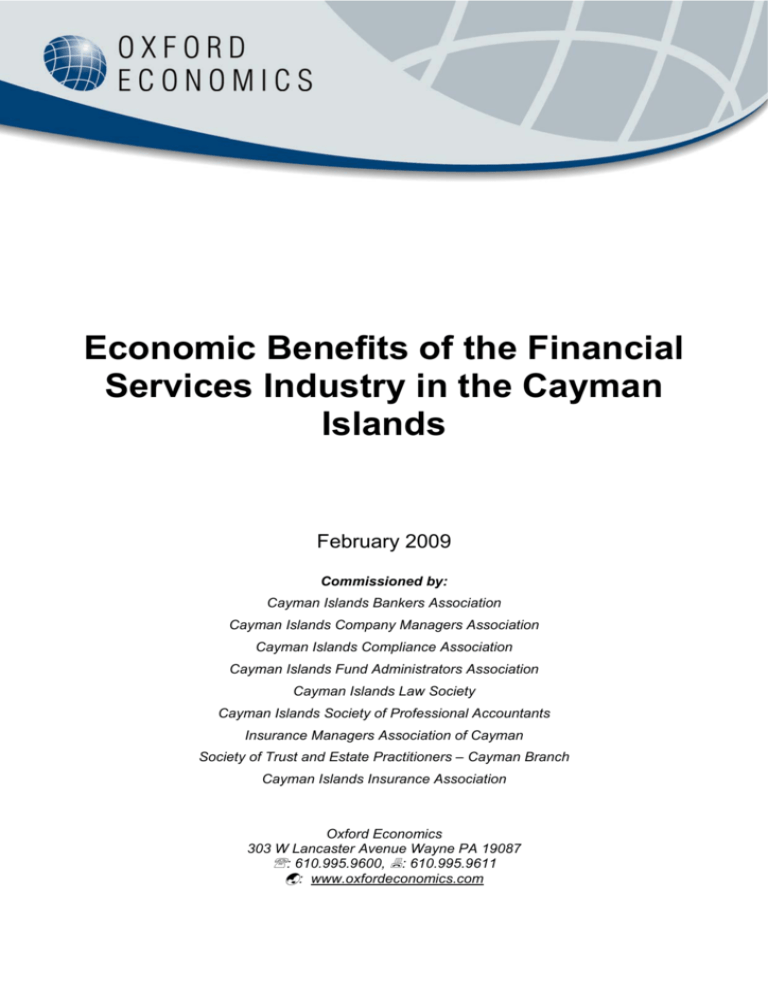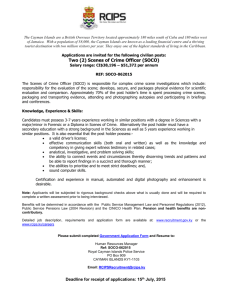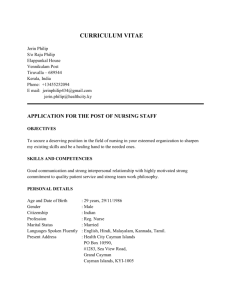
Economic Benefits of the Financial
Services Industry in the Cayman
Islands
February 2009
Commissioned by:
Cayman Islands Bankers Association
Cayman Islands Company Managers Association
Cayman Islands Compliance Association
Cayman Islands Fund Administrators Association
Cayman Islands Law Society
Cayman Islands Society of Professional Accountants
Insurance Managers Association of Cayman
Society of Trust and Estate Practitioners – Cayman Branch
Cayman Islands Insurance Association
Oxford Economics
303 W Lancaster Avenue Wayne PA 19087
℡: 610.995.9600, : 610.995.9611
ß: www.oxfordeconomics.com
Contents
EXECUTIVE SUMMARY
1
1.
INTRODUCTION
3
2.
DIRECT IMPACTS
5
3.
INDIRECT AND INDUCED IMPACTS
7
4.
CATALYTIC EFFECTS
11
Economic Benefits of the Financial Services Industry in the Cayman Islands
February 2009
Executive Summary
The Cayman Islands is widely recognized as one of the most sophisticated offshore centres for financial
services in the world. Cayman’s infrastructure, stability, and conducive regulatory system have fostered
the development of a cluster of sectors related to financial services. This cluster provides a complete suite
of services to investors and companies throughout the world.
To date, no formal assessment of the economic importance of financial services in the Cayman Islands
has been undertaken. (A study of the importance of banking only was conducted in 2006.) This study,
commissioned by a consortium of associations, seeks to understand the complete economic contribution
of the financial services industry (FSI). The definition of financial services is understood to include a
cluster of inter-related sectors. These sectors include banking, insurance, legal services, estate & trust,
company management, fund administration, accountancy, and related regulation and support (including
CIMA, the Cayman Stock Exchange, the Cayman Islands Development Bank, and the Cayman Islands
National Insurance Company).
Although this expands the boundaries of the core “financial services” industry, it better reflects the reality
of the sector’s importance to the Cayman Economy. For example, the vast majority of law firms, company
managers, and accounting firms in Cayman focus on financial services. It is estimated that some 95% of
their business is directly related to financial services. And insurance companies provide an array of
financial services extending beyond insurance alone. The interconnectedness and overlap of services
make each of these sectors an integral part of the overall financial services economy in the Cayman
Islands. On this basis, Oxford Economics has determined:
• Financial services generated CI$ 1.2 billion in GDP in 2007, including direct, indirect, and
induced impacts. This represents 55% of the Cayman economy based on the latest ESO
estimates of total GDP.
• Financial services directly employed 5,723 persons in the Cayman Islands in 2007. Including
downstream impacts, financial services generated employment of 12,603 —representing
36% of all employment in the country. Nearly 60% of these employees are Caymanian.
• Financial services generated personal income of CI$ 687 million in 2007, including direct,
indirect, and induced impacts.
• Financial services directly generated CI$ 204 million in government revenues in 2007, or
40% of all government revenue.
• Over 31,000 visitors came to the Cayman Islands last year as financial services clients,
vendors, or conference participants last year, staying 100,000 nights and spending CI$ 20
million. An additional CI$4 million was spent by companies to host and entertain these
visitors.
1
Economic Benefits of the Financial Services Industry in the Cayman Islands
February 2009
Total FSI Impacts
share of economy
60%
55%
50%
Induced
45%
Indirect
Direct
40%
35%
30%
25%
20%
15%
10%
5%
0%
GDP
Employment
The financial services industry also provides a range of non-quantifiable or “catalytic” benefits to the
Cayman economy.
• Real Estate investment – 20% of respondents indicated that FSI activity encouraged real
estate development
• Training & Education – companies spent over CI$ 4 million for employee training &
education in 2007 ranging from on-the-job training to professional certification and degree
completion.
• Philanthropy – the industries contributed CI $2 million to local organizations, funding
community events and local charities. A limited review of published programs revealed CI$
460,000 in scholarships which are offered to Cayman students. Financial Services Industry
employees volunteered over 59,000 hours to local organizations and programs such as
Junior Achievement.
2
Economic Benefits of the Financial Services Industry in the Cayman Islands
February 2009
1.
Introduction
The financial services industry is integral to the Cayman economy. It is the largest employer and
generator of GDP in the country. Further, financial services supports and drives other sectors of the
economy, encourages investment and improves the quality of that investment, provides a secure home
for domestic savings and access to capital markets for major businesses, as well as providing high paying
job opportunities for Caymanians.
Current economic data for the Cayman Islands do not quantify the GDP impact of financial services.
Further, a holistic picture of financial services in Cayman should include a cluster of related and
interdependent industries.
The basis of this analysis is primarily a survey of financial service-related companies. The sponsoring
organisations encouraged participation in an online and confidential survey which asked companies about
their primary and secondary business activities as well as their employees, revenue (including its
repatriation), wages, business-to-business purchases, and community contributions. A copy of this survey
is included as an appendix to this report. A sample of 107 companies completed the survey, representing
over 3,500 employees, or 70% of all financial services-related employment. The sponsoring organizations
also provided total employment estimates for their respective sector which was constrained by the latest
ESO Labour Force Survey results. Ratios of employment relative to the sample for each industry were
used to project the survey results.
It should be noted here that the results of this survey are largely consistent with data produced by the
Economics and Statistics Office, while providing significant additional detail.
Overall, we find that:
• Considering its full range of impacts, 55% of Cayman GDP is attributable to the financial
services industry, making it the country’s single most important industry.
• Financial service industries support approximately 12,603 jobs in the Cayman Islands, 36%
of total employment. Nearly 60% of these employees are Caymanian.
• The job opportunities in the financial services sector are among the best-rewarded jobs in
the country, yielding significant economic benefits as FSI-generated incomes are spent
across a broad spectrum of the economy.
The rest of the main body of this report considers in detail the contribution that the financial services
industry makes to the Cayman economy in terms of gross domestic product (GDP), employment, income,
and taxes.
3
Economic Benefits of the Financial Services Industry in the Cayman Islands
February 2009
The economic contribution has four components:
Direct impacts – the output created and jobs supported by firms related to financial services. For the
purposes of this study this includes a cluster of inter-related sectors. These sectors include banking,
insurance, legal services, estate & trust, company management, fund administration, accountancy, and
related regulation and support (including CIMA, the Cayman Stock Exchange, the Cayman Islands
Development Bank, and the Cayman Islands National Insurance Company).
Indirect impacts – these are the effects that occur in the wider supply chain of the financial services
industry as these firms purchase goods and services from suppliers in the Cayman Islands. These
impacts are felt in real estate, retail trade, utilities, and other suppliers. Care has been taken not to
double-count the sales among the firms within the financial services cluster.
Induced impacts – these are the impacts that arise from the spending by those people employed in the
financial services industry and its supply chain. In both the indirect and induced impact analysis, import
leakages are accounted for.
Catalytic impacts – the provision of financial services in the Cayman Islands also facilitates the growth
and productivity of other industries. These ‘spillovers’ or ‘catalytic effects’ are not always quantifiable but
have been assessed from the perspective of the industry.
Below, we present each of these effects in turn.
4
Economic Benefits of the Financial Services Industry in the Cayman Islands
February 2009
2.
Direct impacts
The Cayman Islands provides a strong cluster of financial services including banking, estates and trusts,
legal services, insurance, fund administration, and accounting. These sectors are concentrated around
core financial services and have thus been defined as part of the direct impact.
Financial services directly represent CI$ 776 million in GDP. This is 36% of the country’s economy1.
Banking, accountancy, and fund administration represent the largest components of FSI GDP. It is
important to note that overlap exists between these various sectors as many firms provide various
financial services. Therefore industry designation is based on a company’s primary business activity.
FSI Direct Employment Distribution
FSI Direct GDP Distribution
Support
5%
Support
5%
Accountancy
14%
Accountancy
20%
Banking
31%
Banking
34%
Fund
administration
13%
Fund
administration
13%
Insurance
8%
Estate & trust
5%
Insurance
5%
Estate & trust
8%
Law
18%
Law
21%
Financial service industries also sustain more employment than any other economic activity in the
Cayman Islands. 5,723 jobs were directly supported by financial services in 2007, representing 16% of all
employment2. This figure can be compared to the aggregate of 7,532 jobs within the financial services
and business services sectors as reported by the ESO. The ESO figure includes real estate and renting
services which accounts for much of the difference. It should be noted that Oxford Economics has also
included financial services regulation and support within the Cayman Islands Monetary Authority, the
Cayman Stock Exchange, the Cayman Islands Development Bank, the Cayman Islands National
Insurance Company and part of the Finance and Economics Portfolio.
According to the 2007 ESO Labour Force Survey, 71% of employees in the financial service industry (as
narrowly defined) are Cayman Island citizens. Within the expanded definition of financial services
including its related and overlapping sectors, 59% of all employees within the financial services industry
are Caymanian.
1
2
ESO reports 2007 total GDP of CI$2.14 billion
ESO reports 2007 total employment of 35,079 and
5
Economic Benefits of the Financial Services Industry in the Cayman Islands
February 2009
The nature of employment within the financial services industry generates larger secondary impacts
(indirect and induced) than exist within other sectors. There are two reasons for this. Firstly, financial
services do not require significant imports of goods and services as operating inputs. Therefore, costs are
concentrated in local wages and taxes—with relatively low import leakages. Secondly, downstream
spending within the local economy is greater for financial services employee than for the rest of the
economy. Other industries benefit disproportionately from the spending of financial services employees.
These secondary impacts are assessed in detail in the following section.
6
Economic Benefits of the Financial Services Industry in the Cayman Islands
February 2009
3.
Indirect and induced impacts
To understand the full economic impacts of financial services in the Cayman Islands, the linkages and
income effects must also be considered. Specifically, financial service companies purchase goods and
services from local entities outside of the financial service cluster, generating indirect impacts. In
addition—and even more important—employees spend their financial service-generated income in the
Cayman economy, benefiting a range of other sectors via induced impacts. Real estate, utilities,
education, transportation, telecommunications, and health care sectors all benefit as recipients of this flow
of economic activity.
By using an input-output model of the Cayman Islands3, we calculate the linkages of each component of
the financial services sector to other sectors, being careful to net out purchases within the financial
services group as well as purchases made from suppliers outside of the country. Imports are also
excluded from any impacts of consumer purchases.
When including the full range of impacts, the financial services industry generated CI$ 1.2 billion in GDP,
representing 55% of the economy. This includes CI$ 776 million in direct GDP, CI$ 106 million indirectly,
and CI$ 316 million through induced effects. The economic contribution of the 31,000 visitors to the
Cayman Islands on account of financial service is included in the induced impacts.
Millions
FSI GDP Impact by Sector
450
400
Induced
350
Indirect
300
Direct
250
200
150
100
50
t
Su
pp
or
n
Ac
co
un
ta
nc
y
tra
tio
tr u
st
Fu
nd
ad
m
in
is
&
La
w
Es
ta
te
ur
an
ce
In
s
Ba
nk
in
g
0
This analysis indicates that for every dollar of GDP within financial services, another 55 cents is
generated through the supply chain and incomes that are spent within the local economy.
3
The model used was based on Input-Output analysis of Bermuda and adjusted to reflect known totals for the Cayman
Islands. The main assumption was that the relationships of industries to one another and to foreign trade is similar in
both countries.
7
Economic Benefits of the Financial Services Industry in the Cayman Islands
February 2009
Banking, accountancy, and fund administration represent the largest contributions to FSI GDP, followed
by law and insurance services. In should be noted that the indirect and induced impacts by sector are
“driven” by that sector but accrue to sectors outside of financial services.
FSI GDP Impact (CI$, 2007)
Direct
Banking
Insurance
Law
Estate & trust
Fund administration
Accountancy
Support
Travel
TOTAL
Indirect
248,948,898
63,797,650
136,202,871
39,140,966
98,850,907
152,317,519
36,232,186
Induced
Total
42,818,699
6,720,367
3,345,415
10,570,236
17,661,956
19,100,914
6,231,862
84,501,471
376,269,068
18,635,833
89,153,851
58,365,642
197,913,928
18,566,895
68,278,097
48,500,790
165,013,653
54,782,388
226,200,822
12,383,777
54,847,825
20,530,996
20,530,996
775,490,997 106,449,450 316,267,793 1,198,208,240
In addition to the 5,723 jobs directly in the financial services cluster of industries, another 1,744 jobs are
generated within the local supply chain. The induced impacts are particularly significant for employment
given the relatively high incomes within the financial services sector. As a large portion of these incomes
are spent within the local economy, another 5,137 jobs are sustained. This implies that for every direct
financial services job, another 1.2 jobs are generated.
In total, 12,603 jobs are sustained by financial services, comprising 36% of all employment in the Cayman
Islands.
FSI Employment Impact by Sector
4,500
4,000
Induced
3,500
Indirect
3,000
Direct
2,500
2,000
1,500
1,000
500
rt
po
Fu
nd
Su
p
&
tru
st
ad
m
in
is
tra
tio
n
Ac
co
un
ta
nc
y
w
La
Es
ta
te
ce
ra
n
su
In
Ba
nk
in
g
0
8
Economic Benefits of the Financial Services Industry in the Cayman Islands
February 2009
FSI Employment Impact (2007)
Direct
Banking
Insurance
Law
Estate & trust
Fund administration
Accountancy
Support
Travel
TOTAL
Indirect
1,924
310
1,227
435
753
800
274
702
110
55
173
289
313
102
5,723
1,744
Induced
Total
1,385
305
956
304
795
898
203
291
5,137
4,010
725
2,238
912
1,838
2,011
579
291
12,603
Financial services generate substantial personal income in the Cayman Islands including CI$ 477 million
to those directly employed within its companies. Employees within the FSI supply chain received CI$ 45
million in personal income in 2007. And the induced impacts reached CI$ 160 million for a total of CI$ 687
million in personal income, including salaries, benefits, bonuses, and dividends.
200
Induced
Indirect
150
Direct
100
50
Fu
nd
Su
pp
or
t
&
tru
st
ad
m
in
is
tra
tio
n
Ac
co
un
ta
nc
y
w
La
Es
ta
te
In
su
ra
n
ce
0
Ba
nk
in
g
Millions
FSI Personal Income Impact by Sector
9
Economic Benefits of the Financial Services Industry in the Cayman Islands
February 2009
Financial services also generate significant government revenue. In 2007, financial services generated
CI$ 205 million in government revenue. This was 40% of all government revenue4.
FSI-Generated Government Revenue
Import duties
31%
Licensing and
registration
28%
Work Permits
6%
Mortgage and
stamp duties
9%
Other company
fees
25%
Co.
Registration
1%
FSI Government Revenue
CI$, 2007
Licensing and registration
58,241,000
Banks and trust licenses
Mutual fund license and reg.
Law licenses
Traders licenses*
Security investment business
Insurance licenses
24,112,000
20,650,000
1,239,000
3,934,000
1,600,000
6,706,000
Work Permits
Mortgage and stamp duties
Co. Registration
Other company fees
Import duties
Total
* Includes accounting licences
4
11,274,502
17,705,790
2,385,218
51,000,000
63,994,251
204,600,762
ESO reports total government revenues of CI$513 million in 2007
10
Economic Benefits of the Financial Services Industry in the Cayman Islands
February 2009
4.
Catalytic effects
The catalytic impacts of the financial services and related industries represent the ways in which the
economic performance of other industrial sectors is boosted by the activities of the financial services and
related industries, other than via the standard analytical direct, indirect and induced impacts set out
above. It is difficult to quantify the magnitude of these effects. For some industries, they are likely to be
negligible or even zero. But there are good reasons to believe that the financial and related services do
generate such catalytic or “spillover” effects in the Cayman Islands. Some of these impacts tend to be
qualitative, or “soft”, in nature; for example, the ways in which the industry provides support for other
sectors of the economy, or the benefits it provides Caymanians. Others are more quantifiable such as
training expenditures and philanthropic activities. As a part of this report we surveyed the members of the
sponsoring associations in part to ascertain the range and magnitude of these effects.
Our analysis of the 107-firm sample reveals that the
Training & Education
industries’ effects are substantial. First the more
% of respondents
quantifiable effects can be seen in education/training
70%
and community activities. Over 60% of firms
60%
surveyed provide external training to employees and
nearly half provide formal on-the-job training.
50%
Training often includes industry certification and
40%
educational reimbursement programs. Of 75 firms
providing budget information, over CI$3 million was
30%
spent on training and education in 2007. From this,
20%
we estimate that nearly CI$4.3 million was spent on
10%
training for the industry in total.
0%
Formal OJT
External training
Philanthropic Activities
Many of the firms in the industry also contribute to
% of respondents
local charities, scholarship programs and
60%
community events. Of the firms surveyed, nearly
50%
70% contributed either time or financial assistance
to such endeavours. Over 59,000 hours of
volunteer time was donated to organizations and
40%
30%
mentoring programs. In addition some firms
indicate that they encourage their clients, with
success, to donate to local charitable organizations.
Over 25 separate scholarships are also offered to
Cayman students, with a value of CI$ 460,0005.
5
20%
10%
0%
ScholarshipsCommunity
Local
Events
Charities
Other
Volunteer
Hours
Source: Oxford Economics, Cayman Islands Chamber of Commerce
11
Economic Benefits of the Financial Services Industry in the Cayman Islands
February 2009
Although not quantifiable within the scope of this analysis, the survey revealed several other important
ways that financial services benefit the Cayman Islands.
Roughly 20% of respondents indicated
that the financial services industry in
the Cayman Islands improves
residents’ investment opportunities
Benefits to residents
% of respondents
25%
20%
and fosters entrepreneurial
development.
15%
10%
5%
0%
Access to
financing
Investment
opportunities
Security to Entrepreneurial
savings
development
Promoting Local Business
% of respondents
45%
Nearly 40% of respondents stated that
FSI business activity increases
investment within the Cayman Islands
and promotes overall economic
productivity.
40%
35%
30%
25%
20%
15%
10%
5%
0%
Increase local
investment
Improve quality
Promote
productivity/efficiency
12
Economic Benefits of the Financial Services Industry in the Cayman Islands
February 2009
Finally, respondents indicated that
Support of other sectors
% of respondents
financial services benefits overall
60%
economic development, improves
the quality of visitors, and drives
50%
high-end real estate activity.
40%
30%
20%
10%
0%
Facilitates
development
Brings high end
tourism
Brings RE investors
This is evident in data from the Cayman Islands Monetary Authority on the loans made to Cayman
households and businesses. CI$ 2.1 billion was lent by Cayman banks in 2006. CI$ 1.3 billion of this was
extended to households while CI$ 800 million was loaned to businesses.
Loans and advances to CI residents
Loans and advances to CI residents
CI$ (millions)
CI$ (millions)
1,400
2,500
1,200
1,000
2,000
800
1,500
600
1,000
400
200
500
Source: CIMA
2006
2005
2004
2003
2002
2001
2000
1999
1998
1997
0
1996
Personal
Other
Construction
Real estate
Retail
Hotels and
restaurants
Wholesale
Utilities
Agriculture
0
Source: CIMA
13
Economic Benefits of the Financial Services Industry in the Cayman Islands
February 2009
Appendix: Survey of Financial Service Industry Companies
The Economic Impact of Financial Services in The Cayman Islands
To the membership of:
CAYMAN ISLANDS BANKERS ASSOCIATION
CAYMAN ISLANDS COMPANY MANAGERS ASSOCIATION
CAYMAN ISLANDS FUND ADMINISTRATORS ASSOCIATION
CAYMAN ISLANDS LAW SOCIETY
CAYMAN ISLANDS SOCIETY OF PROFESSIONAL ACCOUNTANTS
INSURANCE MANAGERS ASSOCIATION OF CAYMAN
STEP CAYMAN
CAYMAN ISLANDS INSURANCE ASSOCIATION
The above trade associations ('the Associations') have contracted with Oxford Economics to assess the economic importance of
financial services and its associated activities to the Cayman Islands. This survey will take about 5 to 10 minutes and is
designed to enable Oxford Economics to assess the direct and indirect benefits of the financial services and related industries.
All answers should be for the most recently available fiscal year and in Cayman Island dollars where applicable.
This survey is completely anonymous and confidential. No data from any individual firm will be reported or made available to
any person or entity outside of Oxford Economics. Data will only be reported at an aggregated industry level. Oxford
Economics is operating under a non-disclosure agreement with all Associations in this regard.
Direct Economic Benefits
1. What type of Cayman license do you possess?
Class A (Bank or Insurance)
Class B (Bank or Insurance)
Trust
Insurance Managers
Company Managers
Fund Administrator
1
Economic Benefits of the Financial Services Industry in the Cayman Islands
February 2009
Other (please state):
Not applicable
2. What is your primary business activity?
Banking
Insurance (captive)
Insurance (non-captive)
Legal Services
Estate & Trust Services
Company Management
Fund Administration
Accountancy and Audit
Other (please state):
3. What is your secondary business activity?
Banking
Insurance (captive)
Insurance (non-captive)
Legal Services
Estate & Trust Services
Company Management
Fund Administration
Accountancy and Audit
Other
Not applicable
2
Economic Benefits of the Financial Services Industry in the Cayman Islands
February 2009
4. What percentage of your gross annual revenue
in 2007 was generated by this secondary business
activity?
0
5. How many people do you employ in the
Cayman Islands?
0
Approximately what percentage of these
employees are Caymanian?
0
%
persons
%
6. What is your annual gross revenue (CI$)?
Select below or enter gross revenue:
0
CI$
<$1 million
$75-$100 million
$1-$5 million
$100-$150 million
$5-$10 million
$150-$200 million
$10-$20 million
$200-$300 million
$20-$50 million
$300-$500 million
$50-$75 million
Over $500 million
7. What were your total labour costs in 2007 (including benefits, bonuses, dividends,drawings etc.)
of your employees in the Cayman Islands?
Select below or enter cost:
0
CI$
<$1 million
$75-$100 million
$1-$5 million
$100-$150 million
$5-$10 million
$150-$200 million
$10-$20 million
$200-$300 million
$20-$50 million
$300-$500 million
$50-$75 million
Over $500 million
8. What are your annual expenses related to
0
CI$
3
Economic Benefits of the Financial Services Industry in the Cayman Islands
February 2009
facilities (rent, mortgage expenses)?
9. What are your annual expenses for utilities?
Telecommunications:
0
Energy, Water, Sewerage:
0
10. What are your annual expenses on office
equipment and office supplies?
0
11. What percentage of your gross annual
revenue is repatriated to non-Cayman entities?
0
CI$
CI$
CI$
%
12. What taxes and fees were directly paid to the government by your company (CI$)?
License Fees:
0
Work Permit Fees:
0
Property Taxes/Mortgage Fees:
0
Real Estate Stamp Taxes:
0
Company Registration:
0
Other:
0
CI$
CI$
CI$
CI$
CI$
CI$
Please
specify:
Indirect Economic Benefits
13. What proportion of your business is provided to resident Caymanians or local businesses?
<10%
11%-20%
21%-40%
41%-60%
61%-80%
4
Economic Benefits of the Financial Services Industry in the Cayman Islands
February 2009
81%-100%
14. What is the estimated proportion of your clients who also conduct business with the following
sectors in the Cayman Islands (outside of your own sector)?
0%
1-25%
26-50%
51-75%
76-100%
Banks
Insurance
Legal
Trust/Estate
Mutual/Hedge Fund
Accountantcy/Audit
Company Managers
Other
15. Please provide estimates of international client visits to your offices in 2007:
How many clients visited you in 2007?
0
What was their average travel party size?
0
What was their length of stay?
0
What percentage used hotels?
What percentage met with other companies
besides your own while in Cayman?
How many of your clients are property owners
in Cayman?
What were your company's expenditures on
client
entertainment in the Cayman Islands in 2007?
0
0
0
0
persons
persons
days
%
%
%
CI$
5
Economic Benefits of the Financial Services Industry in the Cayman Islands
February 2009
16. How many employees, partners and vendors from offices outside of the Cayman Islands visited
your offices in 2007?
Visits?
0
Average travel party size?
0
Average length of stay?
0
What percentage used hotels?
0
persons
days
%
Catalytic Economic Benefits
17. In what ways does your business support other sectors (e.g. tourism, real estate, construction)?
Facilitates hotel and related real estate development
Brings high-end visitors to the Cayman Islands for tourism
Brings high-end real estate investors to the Cayman Islands
Other (please describe):
18. What sort of training and education programs do you provide?
Formal on-the-job training programs
Formal external training
Informal on-the-job training
Other (please describe):
What was your annual budget for training & education in 2007?:
CI$
6
Economic Benefits of the Financial Services Industry in the Cayman Islands
February 2009
19. What philanthropic and community contributions did your company make in 2007?
Scholarships Amount:
Community
CI$
Amount:
CI$
Local
charities
Amount:
CI$
Other
Amount:
CI$
events
20. How many hours did your company's
employees contribute to volunteer activities in the
Cayman Islands in 2007?
e.g. Junior Achievement, mentoring programs
etc.
0
hours
21. In what ways does your business benefit residents of the Cayman Islands?
Provides access to debt
Provides investment opportunities
Provides greater security to savings
Facilitates entreprenurial development
Other (please describe):
22. In what ways do your services support the local economic activity of your customers? (please
check all that apply)
Leads them to increase their investments in the Cayman Islands
7
Economic Benefits of the Financial Services Industry in the Cayman Islands
February 2009
Leads them to improve their investents in the Cayman Islands
Promotes business productivity/efficiency
Other (please describe):
Thank you for completing the survey.
Please press the Submit button.
Submit
Copyright © September 2008 Oxford Economics Ltd - All rights reserved. Privacy / Disclaimer
8






